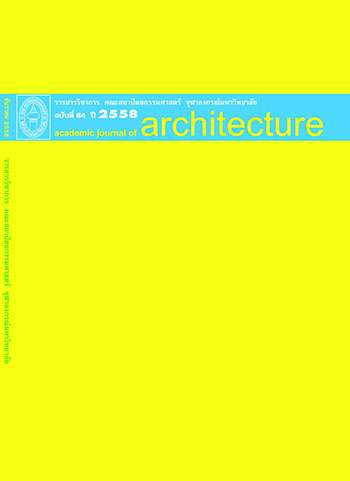Relationship between Moisture Content and Decay of Walls in Ancient Building: A Case of Wat Nivet Thammaprawat, Ayutthaya
Main Article Content
Abstract
Thailand has a long history and great heritage in culture, tradition and language, as well as historical buildings and artifacts which are replete with stories and memories that show the legacy generations have created. However, changes in the environment have occurred in many ways. The climate patterns have become more severe. Also, there have been changes in people’s consumption habits, including using inappropriate methods and materials to renovate and restore old buildings. These changes have led to excessive amount of heat and moisture in buildings, which accelerate the deterioration of historical buildings. This research aims to assess the damage and measure the moisture content in the walls of historic buildings at Wat Niwet Thammaprawat, located in Bang Pa-in, Ayutthaya. The results obtained to analyze the relationship between the level of damage found at the building interior wall surface and the amount of moisture content within the interior walls. Damage assessment of the interior wall surfaces is carried out by sight and the deterioration is divided into three levels: level 1: wall surfaces show no damage; level 2: wall surfaces show some blisters; and level 3: wall surfaces’ paint is peeling off. The method of measurement is the determination of the wall conductivity using high-frequency electric capacitance equipment of which the electricity is passed through the walls to measure the moisture content. The measurements carried out by the equipment show the moisture levels on the interior surfaces of the north and south walls. The results were analyzed in order to find the relationship between two variables, the damage levels and the corresponding moisture content. The results showed that the walls with blistering surface and the paint peeling off (level 3) are found at the height of 0.80 meter above the ground. From the measurements, it was found that the northwestern walls have the most severe damages and the moisture contents are between 45-96%. Less damage were found on the southeastern walls, with the moisture contents between 11%-48%. There is a strong relationship between the level of damages and the moisture content on the northwestern walls, but the relationship is reversed for the southeastern walls which to be further investigated.
Article Details
References
กรมศิลปากร. กลุ่มวิชาการอนุรักษ์โบราณสถาน. ลายเส้นโบราณสถาน วัดนิเวศธรรมประวัติราชวรวิหาร. กรุงเทพฯ : โครงการอนุรักษ์และพัฒนาวัดนิเวศธรรมประวัติราชวรวิหาร กรมศิลปากร, 2553.
กรมศิลปากร. ฝ่ายอนุรักษ์จิตรกรรมฝาผนัง และประติมากรรมติดที่. สรุปผลการสัมมนาเรื่องการอนุรักษ์จิตรกรรมฝาผนัง และการอนุรักษ์พระพุทธรูป. กรุงเทพฯ : มูลนิธิ ฟอร์ดแห่งประเทศไทย, 2533.
จิราภรณ์ อรัณยะนาค. “การเสื่อมสภาพของโบราณสถานและโบราณวัตถุ.” ใน การประชุมทางวิชาการของมหาวิทยาลัยเกษตรศาสตร์ ครั้งที่ 21 สาขาสิ่งแวดล้อม 31 มกราคม - 3 กุมภาพันธ์ 2526, ส่วนที่ 21 : (12 หน้า). กรุงเทพฯ: มหาวิทยาลัยเกษตรศาสตร์, 2556.
เธียรวิภา กลิ่นบุบผา. “ความสัมพันธ์ระหว่างปัจจัยทางชีวภาพและกายภาพที่ส่งผลต่อการเสื่อมสภาพของโบราณสถานบางแห่งใน จ.พระนครศรีอยุธยา.” วิทยานิพนธ์ปริญญาวิทยาศาสตรมหาบัณฑิต, สาขาวิชาวิทยาศาสตร์สิ่งแวดล้อม, คณะวิทยาศาสตร์และเทคโนโลยี, มหาวิทยาลัยธรรมศาสตร์, 2552.
พัชร์วิไล พงษ์พานิช. “อัตราการกัดกร่อนอิฐเก่าจากก๊าซซัลเฟอร์ไดออกไซด์.” วิทยานิพนธ์ปริญญาวิทยาศาสตรมหาบัณฑิต, สหสาขาวิชาวิทยาศาสตร์สิ่งแวดล้อม, จุฬาลงกรณ์มหาวิทยาลัย, 2547.
ภัทรวรรณ พงศ์ศิลป์. “การศึกษาสถาปัตยกรรมวัดปทุมวนารามราชวรวิหาร กรุงเทพมหานคร.” วิทยานิพนธ์ปริญญาศิลปศาสตรมหาบัณฑิต, สาขาวิชาประวัติศาสตร์สถาปัตยกรรม, คณะสถาปัตยกรรมศาสตร์, มหาวิทยาลัยศิลปากร, 2549.
วิชญาดา เตชาดิศัย. “ประสิทธิภาพของสารกันซึมที่ใช้เคลือบผิวอิฐเพื่อป้องกันความชื้น.” วิทยานิพนธ์ปริญญาวิทยาศาสตรมหาบัณฑิต, สหสาขาวิชาวิทยาศาสตร์ สภาวะแวดล้อม, จุฬาลงกรณ์มหาวิทยาลัย, 2544.
สุริยน ศิริธรรมปิติ. “ปัจจัยที่มีผลต่อการควบแน่นในโบราณสถาน: กรณีศึกษาพระอุโบสถวัดกำแพง.” วิทยานิพนธ์ปริญญาสถาปัตยกรรมศาสตรมหาบัณฑิต, สาขาวิชาเทคโนโลยีอาคาร, ภาควิชาสถาปัตยกรรมศาสตร์, จุฬาลงกรณ์มหาวิทยาลัย, 2542.
สุวิชา เบญจพร. “อิทธิพลของความชื้นที่แทรกซึมผ่านผนังทึบของอาคารปรับอากาศ.” วิทยานิพนธ์ปริญญาสถาปัตยกรรมศาสตรมหาบัณฑิต, สาขาวิชาเทคโนโลยีอาคาร, ภาควิชาสถาปัตยกรรมศาสตร์, จุฬาลงกรณ์มหาวิทยาลัย, 2544.
อนัญญา โพธิ์ประดิษฐ์. “ความผันแปรของการสะสมความชื้นในผนังอาคารโบราณสถานบางแหงในจังหวัดพระนครศรีอยุธยา” วิทยานิพนธ์ปริญญาวิทยาศาสตรมหาบัณฑิต, สาขาวิชาวิทยาศาสตร์สิ่งแวดล้อม, ภาควิชาวิทยาศาสตร์สิ่งแวดล้อม, คณะวิทยาศาสตร์และเทคโนโลยี, มหาวิทยาลัยธรรมศาสตร์, 2554.
อนงค์ อนันต์รัตนสุข. “รายงานผลการดําเนินภารกิจงาน ของสํานักงานวัฒนธรรมจังหวัดพระนครศรีอยุธยา” พระนครศรีอยุธยา : สำนักงานวัฒนธรรม จังหวัดพระนครศรีอยุธยา, 2555.
อรรจน์ เศรษฐบุตร, ณัฐนี วงศ์วีระนนท์ชัยและสริน พินิจ. แนวทางการแก้ปัญหาความชื้นในองค์พระพุทธไสยาสน์ วัดสะตือ จ.พระนครศรีอยุธยา, เอกสารประกอบการประชุมวิชาการครบรอบ 25 ปี คณะสถาปัตยกรรมศาสตร์ มหาวิทยาลัยขอนแก่น. ขอนแก่น : มหาวิทยาลัยขอนแก่น, 2556.
Beall, Cristine. Thermal and Moisture Protection Manual for Architects, Engineers, and Contractors. New York: McGraw-Hill Companies, 1999.
Gratwick, R.T. Dampness in Building. London: Crosby Lockwood Staples, 1974.


